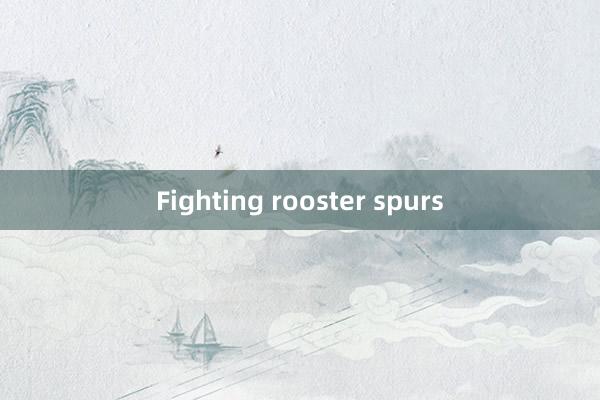
The Fascinating World of Fighting Rooster Spurs
Fighting roosters, also known as gamecocks, have long been admired for their physical prowess, agility, and tenacity. While cockfighting is illegal in many parts of the world, the historical and cultural significance of these birds is undeniable. One of the most essential aspects of a fighting rooster’s weaponry is its spurs. These sharp, pointed projections on the legs of the birds serve as powerful tools during fights, often determining the outcome of a battle. In this article, we will explore the anatomy, purpose, and cultural impact of fighting rooster spurs, delving into the tradition and symbolism that has surrounded them for centuries.
Understanding the Anatomy of Rooster Spurs
Spurs are natural appendages that grow from the back of a rooster's leg. While all male chickens develop spurs, those bred for fighting have particularly well-developed and sharp spurs. These spurs are made of keratin, the same protein that makes up human hair and nails. Over time, the spur becomes harder and sharper, forming a formidable weapon.
In addition to their natural spurs, fighting roosters are often equipped with artificial spurs during cockfighting events. These spurs, typically made from metal or plastic, are designed to enhance the rooster's fighting ability, making the fights more intense and, unfortunately, more dangerous for the birds. Artificial spurs are often fitted over the natural spur or tied to the rooster's legs. Their length and sharpness can vary, but they are typically crafted to cause more damage in a shorter time.
The Role of Spurs in Cockfighting
In cockfighting, libre ang jili spurs are crucial to the fight’s outcome. When two roosters are set against each other, Joy JILI casino Login Philippines they use their spurs to strike at their opponent’s body, Jili Live777 aiming for vulnerable areas such as the neck, Abc jili1 head,Lodi777 and sides. A well-aimed strike from a strong rooster can incapacitate or even kill the opposing bird within minutes. Roosters are known for their fierce and relentless nature, and spurs only amplify their aggression.
Throughout history, cockfighting has been seen as a test of both skill and luck. The rooster with the most refined physical attributes, particularly strong and sharp spurs, stands a better chance of winning. However, fighting ability is not determined solely by physical prowess. A rooster’s temperament, stamina, and training are equally important factors.
Cultural Significance of Fighting Rooster Spurs
go88 playThe tradition of cockfighting dates back thousands of years and has been practiced in many parts of the world, from ancient Greece and Rome to Southeast Asia and Latin America. In many cultures, fighting roosters and their spurs hold deep symbolic meaning, representing strength, courage, and virility.
In Southeast Asian cultures, particularly in the Philippines, Indonesia, and Thailand, cockfighting has a long-standing cultural importance. In the Philippines, for example, cockfighting, known as "sabong," is a deeply ingrained tradition that has been practiced for centuries. The sharpness and effectiveness of a rooster’s spurs are seen as a reflection of its fighting spirit, making them central to the sport’s cultural significance. Bets are placed based on the rooster’s physical attributes, including its spurs, and the outcome of the fight can carry significant social or even political weight in some regions.
In Latin American countries like Mexico, cockfighting is also a cultural symbol of pride and masculinity. The sport has been linked to both social status and tradition, with the spurs representing the honor and fighting spirit of the participants. In some areas, the best fighting roosters are considered prized possessions, and breeders go to great lengths to ensure their birds develop strong spurs. Breeding roosters with the ideal combination of physical and behavioral traits is a source of pride for many.
Ethical Concerns and the Future of Cockfighting
As awareness of animal rights grows worldwide, the ethics of cockfighting and the use of spurs have come under increasing scrutiny. In many countries, cockfighting is illegal, and those caught participating in or organizing such events face heavy fines or imprisonment. Animal welfare groups argue that the use of spurs in cockfighting causes unnecessary suffering to the animals, as the sharp spurs can lead to severe injury or death.
While some advocates for cockfighting argue that the sport is part of their cultural heritage, the global trend is moving toward greater protection for animals. In places where cockfighting is still legal, there are discussions about regulating the sport to reduce harm, including limiting the use of artificial spurs or enforcing stricter rules to protect the birds involved.
Conclusion
Fighting rooster spurs play a crucial role in the world of cockfighting, both as physical weapons and as cultural symbols. While they have been a central part of the sport for centuries, the ethical concerns surrounding their use are growing louder. As societies increasingly prioritize animal welfare, the future of cockfighting and the use of spurs may continue to evolve. However, the historical significance and symbolism of these formidable weapons will likely remain a point of fascination for many who study the traditions of this ancient sport.
JILI downloadwww.voyeurbrazil.com








